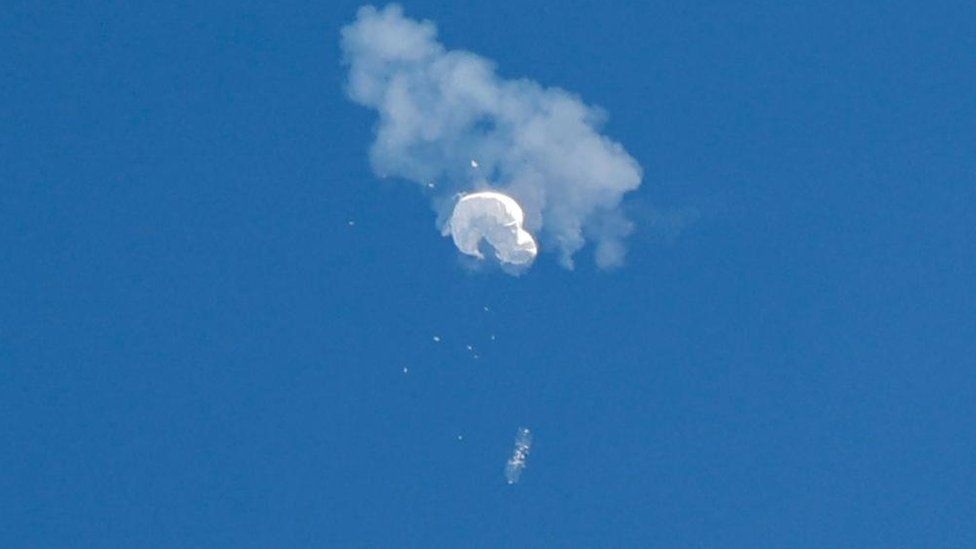A suspected Chinese surveillance balloon that the US shot down this week was able to collect communications signals, a US official has said.
It was equipped with multiple antennas capable of “intelligence collection operations”, a senior State Department official said in a background briefing.
On Thursday, US lawmakers passed a non-binding resolution condemning China for the balloon.
China has denied the balloon was used for spying purposes.
It has said the balloon was a weather device blown astray.
The US, however, believes the balloon is part of a wider fleet of surveillance balloons that has spanned five continents.
House of Representatives lawmakers called the balloon a “brazen violation of United States sovereignty” as the body voted 419 to 0 on Thursday morning to condemn its use.
Its appearance in US airspace has provoked a diplomatic crisis and led US Secretary of State Antony Blinken to cancel a trip to China – the first such high level US-China meeting there in years. The US military used a fighter jet to shoot the balloon down over the Atlantic Ocean over the weekend.
READ ALSO:
China on Thursday said it was not aware of any wider fleet of surveillance balloons. The claim is “probably part of the information and public opinion warfare the US has waged on China”, Chinese Foreign Ministry spokesperson Mao Ning said.
China also took aim at US President Joe Biden after he said during a PBS interview that Chinese leader Xi Jinping was facing “enormous problems”. Those remarks were “highly irresponsible and violate basic diplomatic protocols”, Ms Ning said.
The senior State Department official said on Thursday that high resolution images revealed the balloon – which was about 200 ft (60 metres) tall – had large solar panels capable of operating “multiple active intelligence collection sensors” as well as antennas that were able to collect and geo-locate communications.
The US is considering taking action against groups linked to the Chinese government that were involved in the balloon’s flight, the official said.
The latest US government information suggests that the craft indeed was some type of surveillance balloon, experts told the BBC.
“The types of antennas are meant for surveillance technology and this is not something you would expect for any type of scientific mission,” said Gregory Falco, an assistant professor at Johns Hopkins University’s Department of Civil and Systems Engineering.
It’s still not possible to glean exactly what type of data China might have been trying to gather on the balloon mission, experts said, but it may have intercepted radio, cell phone and other communications from the military bases it flew over, said Matt Kroenig, the senior director of the Scowcroft Center for Strategy and Security at the Atlantic Council.
The balloon’s large solar panels – as well as the fact that it was able to hover over US airspace for long periods of time – is concerning, Dr Falco said.
“They have a high-powered system that can do a lot of data relay,” said Dr Falco. “I don’t know exactly what they were collecting, but all the mechanics are there for getting a lot of data back to their satellites.”
The US may have taken countermeasures to prevent China from gathering data, including jamming equipment, Dr Kroenig said.
The FBI said that its lab is helping process debris that has been collected, which has so far included parts of the balloon canopy, wires and electronic components collected from the surface of the sea.
Most of the balloon’s “payload” – which would likely include surveillance gear and other items of interest to investigators – remains underwater off the South Carolina coast. Officials warn that processing the wreckage could take a long time, which could be prolonged by poor weather conditions.
US intelligence, military and foreign policy officials began briefing members of Congress on Thursday about the balloon.
The hearings come amid mounting criticism of the Biden administration’s handling of the incident from his political opponents.
On Wednesday, an open letter from Republican Senators Marco Rubio and Roger Wicker said they lack “a clear understanding” of the government’s response to the balloon.
Speaking to senators, US Army Lieutenant General Douglas Sims said that “the risk of Chinese intelligence collection was low to moderate” as the balloon flew over the US.
The potential of harming civilians on the ground if it was shot down over land, conversely, was “moderate to significant”.
Officials also defended the timing of the balloon’s destruction, saying that doing so over rough terrain in Alaska or the cold waters of the Northern Pacific would have made recovery efforts difficult and dangerous.
At a Wednesday news conference, Defence Department spokesman Brigadier General Pat Ryder confirmed that the US believed similar balloons had operated over North and South America, South East Asia, East Asia and Europe.


